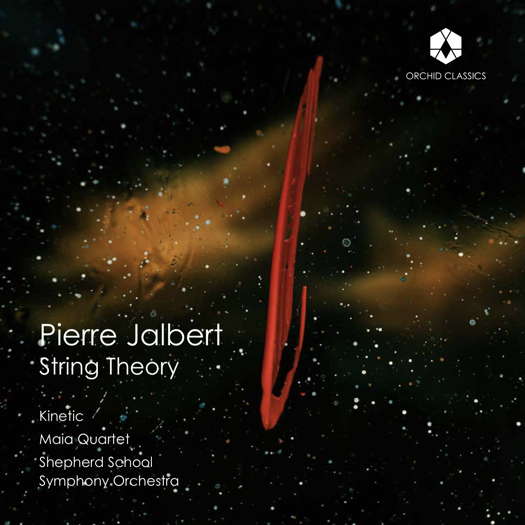 FEEDBACK: She said WHAT? Read what people think about our Classical Music Daily features, and have your say!
FEEDBACK: She said WHAT? Read what people think about our Classical Music Daily features, and have your say!

The Syntax of Worlds
JOHN DANTE PREVEDINI listens to music by American composer Pierre Jalbert
'... Jalbert ... implies a novel dimension of meaning by presenting distinct sonic universes in a syntactically suggestive sequence.'
Orchid Classics' recent release, String Theory, is a collection of previously unrecorded works for string orchestra, string quartet and full orchestra by the American composer Pierre Jalbert as performed by Kinetic, the Maia Quartet and the Shepherd School Symphony Orchestra. The hour-long release is available in both CD and digital format, and the accompanying materials include reflections and program notes by the composer.
Jalbert is someone whose work I had the pleasure of encountering once before, in 2017, when I attended the East Coast (US) premiere of his sixth string quartet at the Hartt School by the Chiara String Quartet. Jalbert's creative voice struck me at the time as one with a solid footing in multiple sonic and structural worlds, able to draw freely from those wells at will and to integrate the disparate resulting materials fluidly and organically. Four years later, hearing this new collection from Orchid Classics now reaffirms and further highlights those initial impressions.
There are perhaps many theoretical ways to 'slice' Jalbert's complex and multilayered palette, but the clearest to me - as framed by the context of this release - is perhaps as a triad of three worlds whose artifacts interact through various emergent syntaxes. By worlds here I do not mean set bodies of material; on the contrary, Jalbert's content strikes me as fresh and spontaneous at every step. I mean, rather, something akin to distinct spaces that Jalbert seems to simultaneously inhabit, each one being articulated by means of a particular set of sonic tools and conveying a particular state of mind. The first of these worlds I would broadly describe as aggressive and percussive, characterized by asymmetric meters, rhythmic 'grooves' and various structural features that seem to suggest an influence of heavy metal. The second world I would describe as lyrical, reverberant, slow and free with considerable flexibility along harmonic and timbral parameters. The third of these worlds I would characterize as lively, energetic, bright and subtly playful, characterized by bowed scalar runs and quick pizzicato passages in the strings. I would say that all three of these worlds share a thematic organizational structure that is more motivic than melodic, a textural structure that emphasizes layering and the use of ostinati to convey momentum.
The album opens with the eponymous three-movement String Theory for string orchestra, which the composer describes as being based on the symbolism of the harmonic series produced by dividing a single string. Movement one, Partials, explores this mostly through the aggressive-percussive world, incorporating literal overtones in various layers of the string writing.
Listen — Jalbert: Partials (String Theory)
(track 1, 0:00-0:30) ℗ 2021 Orchid Music Ltd :
Movement two, Timeless, takes this same principle into the dimension of the lyrical world and apparently alludes to the branch of theoretical physics that shares the composition's name.
Listen — Jalbert: Timeless (String Theory)
(track 2, 0:00-0:30) ℗ 2021 Orchid Music Ltd :
Movement three, Rhythmus, combines elements of the first two movements, blending the aggressive-percussive with the lyrical and employing rhythmic pulse as a symbol of harmonic vibration.
String Theory is followed by two single-movement works, also for string orchestra. Autumn Rhapsody showcases a balanced synergy among the worlds of the aggressive-percussive, the lyrical and the lively in a seamless portrayal of a changing seasonal landscape. Here Jalbert recalls his Vermont roots and pays tribute to the memory of his composition teacher Arlene Cleary. Elegy takes Jalbert's lyrical world into highly effective somber territory with climactic hints of the aggressive-percussive, and it uses some of the darkest treatments of the Lydian mode I have heard in recent memory.
The String Quartet No 3 follows, in three movements. Jalbert indicates in the liner notes that this quartet employs a programmatic structure based on a story by Hans Christian Andersen, though he does not specify which story. The quartet opens with the lyrical and lively Prelude (h.c.a.), the movement title referring to Jalbert's transformation of the writer's initials into a musical motive on the notes B-natural, C and A. (This uses the German convention, in which 'H' represents B-natural and 'B' represents B-flat.) The second movement is the Scherzo in 15 Scenes, which draws upon all three of Jalbert's sonic worlds to form a continuous dramatic arc characterized by contrasts, abrupt energetic shifts and ever-morphing tension.
Listen — Jalbert: Scherzo in 15 Scenes (String Quartet No 3)
(track 7, 0:00-0:30) ℗ 2021 Orchid Music Ltd :
The piece concludes with a brief Finale blending the aggressive-percussive with the lively. Here Jalbert is perhaps at his most explicitly melodic, showcasing a highly angular main theme introduced over a pulsating mixed-third chord. The work was commissioned by the Maia Quartet, who perform on this recording.
The album ends with In Terra, commissioned and performed here by Rice University's Shepherd School Symphony Orchestra. Jalbert describes the work in the liner notes as portraying the literal formation and evolution of planet earth, directly referencing his orchestral 'layering' technique as a means of representing geological layers in a state of flux over eons. The worlds of the aggressive-percussive, the lyrical and the lively come together to convey this programmatic premise with an almost cinematic level of vividness.
In the five works featured on the String Theory release, Pierre Jalbert finds ways to reconcile seemingly unrelated worlds of compositional material through mutual contextualization. As all life on earth arises from the sequences of just four nucleotides and all the literature in English arises from the sequences of just twenty-six basic letters, here Jalbert likewise implies a novel dimension of meaning by presenting distinct sonic universes in a syntactically suggestive sequence. How appropriate this seems for a composer who contemplates the genesis of harmony from a single string, the range of colors nature unveils in a single season and the volatile forces behind terra firma itself.
Copyright © 10 November 2021
John Dante Prevedini,
Connecticut, USA

CD INFORMATION - PIERRE JALBERT: STRING THEORY
MORE ARTICLES ABOUT CONTEMPORARY MUSIC
MORE CLASSICAL MUSIC ARTICLES ABOUT THE USA
RECENT CLASSICAL MUSIC CD REVIEWS



